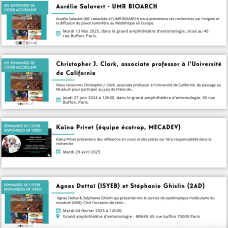Ming-Kai Tan de l’ISYEB

ISYEB

ISYEB
From Individuality to Species: Personality and Evolution of Acoustics Communication in Eneopterinae Crickets
Individual fitness can be boosted by behavioural strategies that maximise mate finding probability while reducing the danger of predation. Animals that sing to find mates may therefore benefit from strategising between stationary calling and active exploration. Studying the variations and differences in both behaviours allows us to understand how and why individuals, populations and species can differ in their behavioural strategisation. However, investigating the inter-individual variability of exploration and acoustic signal parameters concurrently are still rare. To (1) examine questions related to personality and individuality in acoustics and (2) understand how such individuality evolve, I study the Eneopterinae crickets which are unique in that the males explore and call while searching for females, unlike typical gryllid crickets. In this seminar, I will first talk about the inter-individual differences of these acoustic parameters and exploratory traits and the behavioural syndromes connecting acoustic parameters and behavioural traits. I found that while some individuals consistently sing and explore more than others, suggesting that lebinthines may also use multiple strategy patterns to cope with unpredictable risk–benefit scenarios—some individuals are consistently more exploratory and sing longer while others are either less vocal but highly exploratory or vice versa. Next, even though the COVID-19 pandemic may have drastically disrupted my research plans, I took the opportunity to examine population differences of acoustic parameters and behavioural traits in the wild populations of Lebinthus luae in Singapore before and after a lockdown due to the COVID-19 pandemic. I found that populations were affected by microevolution to specific call patterns at different scales for different properties and that there is a hierarchical change in response to human presence. Lastly, I will also present on my latest results showing species- and individual-differences in the circadian patterns of their calling activity among 10 species of eneopterines.



